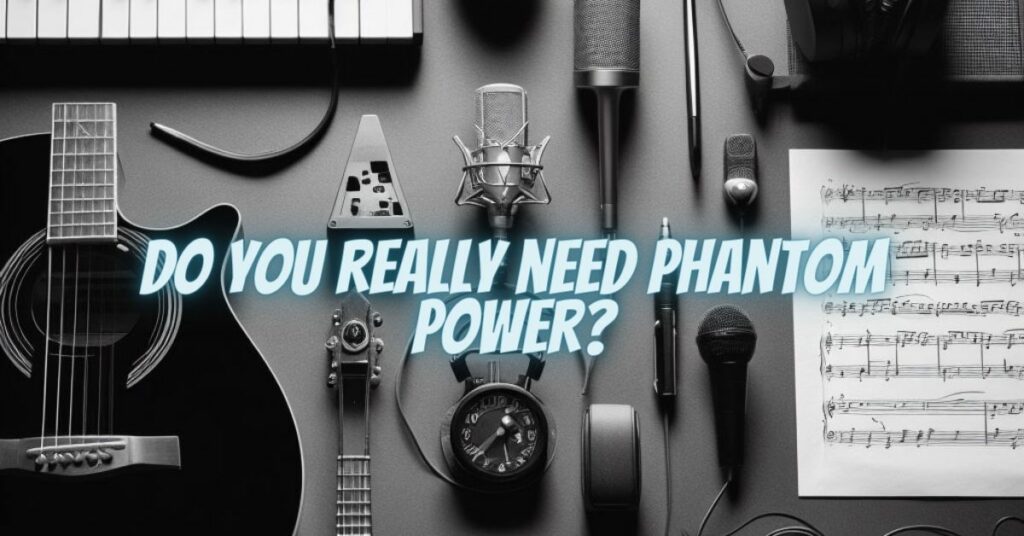Phantom power is a type of electrical power supply that is used to power electronic devices in professional audio equipment. It is typically supplied through the microphone cable and is used to power condenser microphones, active DI boxes, and other types of audio gear.
What is phantom power?
Phantom power is a DC voltage that is supplied to the microphone through the XLR cable. The voltage is typically 48 volts, but there are also some devices that use 24 volts. Phantom power is supplied through the two center pins of the XLR cable, while the audio signal is carried on the two outer pins.
Why do some microphones need phantom power?
Condenser microphones require phantom power to operate. Condenser microphones use a capacitor to convert sound waves into electrical signals. The capacitor is made up of two thin metal plates that are separated by a very thin layer of air. The sound waves cause the plates to vibrate, which creates an electrical signal.
The electrical signal from the condenser microphone is very weak, so it needs to be amplified before it can be recorded. The phantom power is used to power the amplifier circuit in the condenser microphone.
What other devices use phantom power?
In addition to condenser microphones, phantom power is also used to power active DI boxes and other types of audio gear. Active DI boxes use phantom power to power their internal circuitry, which allows them to boost the signal from the instrument and provide impedance matching.
Other types of audio gear that may use phantom power include:
- Electret microphones
- Ribbon microphones
- Tube microphones
- Lavalier microphones
- Wireless microphone systems
- Audio mixers
- Preamplifiers
- Interfaces
Do I need phantom power?
Whether or not you need phantom power depends on the type of microphones and other audio gear that you are using. If you are using condenser microphones, active DI boxes, or other types of audio gear that require phantom power, then you will need to make sure that your audio interface or mixer has phantom power enabled.
If you are using dynamic microphones, then you do not need phantom power. Dynamic microphones do not have any active electronics, so they do not need any external power to operate.
Is phantom power safe?
Phantom power is safe for most audio equipment. However, it is important to check the specifications of your microphones and other audio gear before enabling phantom power. Some microphones, such as ribbon microphones, can be damaged by phantom power.
It is also important to note that phantom power should always be turned off before connecting or disconnecting microphones. This will help to prevent any pops or noises from occurring.
Tips for using phantom power
Here are a few tips for using phantom power:
- Always check the specifications of your microphones and other audio gear before enabling phantom power.
- Turn off phantom power before connecting or disconnecting microphones.
- Use a high-quality XLR cable to connect your microphones to your audio interface or mixer.
- If you are using phantom power with ribbon microphones, be sure to use a phantom power adapter that is specifically designed for ribbon microphones.
Phantom power is a valuable tool for audio professionals. It allows them to use condenser microphones, active DI boxes, and other types of audio gear that require external power. However, it is important to use phantom power safely and to check the specifications of your equipment before enabling it.
Additional insights
Phantom power is a relatively new technology. It was first introduced in the 1960s, and it has become increasingly popular in recent years. This is due to the increasing use of condenser microphones, which offer superior sound quality to dynamic microphones.
Phantom power is a very versatile technology. It can be used to power a wide variety of audio equipment, from condenser microphones to active DI boxes to wireless microphone systems. This makes it an essential tool for any audio professional.
Phantom power is also relatively affordable. Most audio interfaces and mixers have phantom power built in, and there are also a number of standalone phantom power adapters available. This makes it easy and affordable to add phantom power to your audio setup.
Overall, phantom power is a valuable tool that can help you to improve the sound quality of your recordings. If you are using condenser microphones, active DI boxes, or other types of audio gear that require phantom power, then I encourage you to learn more about this technology and how to use it safely and effectively.


